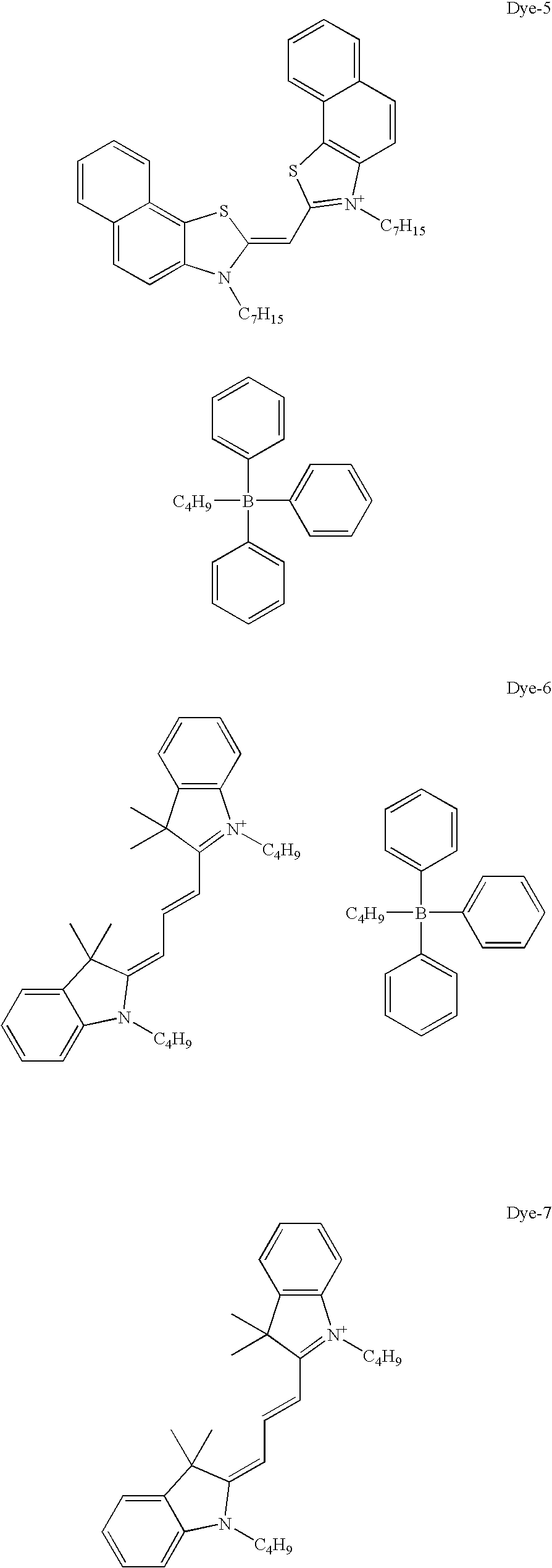Method of coating a multilayered element
- Summary
- Abstract
- Description
- Claims
- Application Information
AI Technical Summary
Benefits of technology
Problems solved by technology
Method used
Image
Examples
example 1
Preparation of Multilayer Element 1
[0144] A water-absorbing layer P consisting of gelatin, LP-1 and hardener bis(vinylsulfonyl methane) at the weight ratio of 100:100:3 was coated by slide hopper onto a moving white opaque support (8 mil Granwell Polylith GC2 oriented polypropylene synthetic paper having polyolefin resin coated layers on both sides) that had been previously corona discharge treated. The web was passed through a chilled section of 4°-6° C. to immobilize the coating solution, followed by a series of drying sections to remove the excess water. The thickness of the resulting dry layer is approximately 16 μm.
[0145] Coating solutions for the multilayer coating process of this invention to produce Element 1 were prepared by mixing all the components described below in water. The gelatin used in layer 2 and layer 3 is acid processed ossein from Croda. Coating solutions for Layer 2 and Layer 3 were prepared at 50° C. Preparation of the coating solution for the light and pr...
example 2
Preparation of Elements 2 to 4
[0149] Elements 2 to 4 were prepared similarly to Element 1, except that the composition and wetload of Layer 2 were different, as listed below.
ComponentLaydown (g / m2)Layer 2 of Element 2APO Gelatin3.23UV-1 / UV-20.43(@ 15 / 85 wt ratio)LP-23.23SF-10.01Wet Laydown30.14Layer 2 of Element 3APO Gelatin4.84UV-1 / UV-20.43(@ 15 / 85 wt ratio)LP-21.61SF-10.01Wet Laydown30.14Layer 2 of Element 4APO Gelatin2.15UV-1 / UV-20.43(@ 15 / 85 wt ratio)LP-22.15SF-10.01Wet Laydown21.53
[0150] LP-2 is an acrylic emulsion polymer Aroset 3240™, available from Ashland Specialty Chemical Company (Columbus, Ohio), having a glass transition temperature of ˜−35° C., and an average particle size of 345 nm.
Layer 1 WetLayers 2 & 3 WetWet laydown of chill settableLaydownLaydownlayer(s) based onElement(g / m2)(g / m2)non-chill settable layer173.4147.9065%273.4138.2152%373.4138.2152%473.4129.6040%
[0151] Element 5 was prepared similarly to Element 1, except that chill settable protective Layers 2...
example 3
Rheology of Coating Solutions for Layers 1, 2 & 3
[0153] Coating solutions for Layer 1. Layer 2, and Layer 3 used to prepare Element 3 were measured for their chill setting property. A controlled-strain rheometer, Rheometrics ARES Fluids Spectrometer, was used with couette geometry. The geometry has a cup diameter of 34 mm, and a bob diameter and length of 32.4 mm and 33 mm respectively. A sample volume of 12 mL was used. The dynamic viscosity at a frequency of 1 rad.s−1 as recorded and the temperature was ramped at 1 c / minute from 45° C. to 5° C. A plot of the log of dynamic viscosity versus linear temperature was generated. The chill setting (gelation) temperature was defined as the temperature that the rate of viscosity change is the highest, i.e., the temperature where the slop is the highest on the log of dynamic viscosity versus linear temperature plot.
[0154] The coating solution for Layer 2 has a chill set temperature of 29° C., and the coating solution for Layer 3 has a chi...
PUM
 Login to View More
Login to View More Abstract
Description
Claims
Application Information
 Login to View More
Login to View More - R&D
- Intellectual Property
- Life Sciences
- Materials
- Tech Scout
- Unparalleled Data Quality
- Higher Quality Content
- 60% Fewer Hallucinations
Browse by: Latest US Patents, China's latest patents, Technical Efficacy Thesaurus, Application Domain, Technology Topic, Popular Technical Reports.
© 2025 PatSnap. All rights reserved.Legal|Privacy policy|Modern Slavery Act Transparency Statement|Sitemap|About US| Contact US: help@patsnap.com



